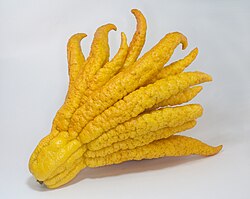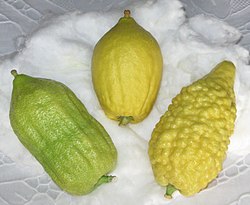This article needs additional citations for verification .(February 2020) |
| Buddha's hand | |
|---|---|
 | |
| Buddha's hand fruit, "open hand" appearance when ripe | |
| Scientific classification | |
| Kingdom: | |
| (unranked): | |
| (unranked): | |
| (unranked): | |
| Order: | |
| Family: | |
| Genus: | |
| Species: | |
| Variety: | C. m. var. sarcodactylis |
| Trinomial name | |
| Citrus medica var. sarcodactylis (Hoola van Nooten) Swingle | |
| Citron varieties |
|---|
 |
| Acidic-pulp varieties |
| Non-acidic varieties |
| Pulpless varieties |
| Citron hybrids |
| Related articles |
| Buddha's hand | |||||||
|---|---|---|---|---|---|---|---|
| Chinese name | |||||||
| Chinese | 佛手柑 | ||||||
| |||||||
| Vietnamese name | |||||||
| Vietnamese | quảphật thủ | ||||||
| Korean name | |||||||
| Hangul | 불수감 | ||||||
| Hanja | 佛手柑 | ||||||
| |||||||
| Japanese name | |||||||
| Kanji | 仏手柑 | ||||||
| Hiragana | ぶっしゅかん | ||||||
| Katakana | ブッシュカン | ||||||
| |||||||
Citrus medica var. sarcodactylis,or the fingered citron,is a citron variety whose fruit is segmented into finger-like sections,resembling those seen on representations of the Buddha. It is called Buddha's hand in many languages including English,Chinese,Japanese,Korean,Vietnamese,German and French.
Contents
- Description
- Uses
- Perfumery
- Religious
- Ornamental
- Food and medicine
- Gallery
- See also
- References
- External links
The different cultivars and variations of this citron variety form a gradient from "open-hand" types with outward-splayed segments to "closed-hand" types,in which the fingers are kept together. There are also half-fingered fruits,in which the basal side is united and the apical side fingered. The origin of this kind of citron is commonly traced back to South or East Asia,probably northeastern India or China,where most domesticated citrus fruits originate. [1]












